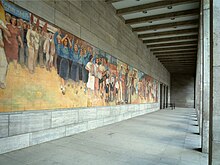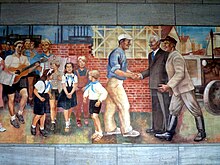Max Lingner


Max Lingner (born November 17, 1888 in Leipzig , † March 14, 1959 in Berlin ) was a German painter, graphic artist and resistance fighter against the Nazi regime.
Life
As the son of a xylograph he passed his Abitur in 1907 and studied as a master class student with Carl Bantzer at the Dresden Art Academy , where he completed his training in 1912 with a painting Singing Girls , for which he received the “Saxon State Prize”. On a study trip in 1913/1914 he visited England, the Netherlands, France and Belgium.
In the First World War he had to fight on all fronts. In 1918 he took part in the sailors 'uprising and became a member of the soldiers' council in Kiel . He settled in Born auf dem Darß from 1919 to 1922, but failed as a farmer. From 1922 to 1927 he worked as a painter and graphic artist in Weißenfels , but there were no major successes. On advice from Käthe Kollwitz , he moved to Paris .
The first few years in Paris also went without any major impressions for him. The tide turned when Henri Barbusse won him over to work for the weekly newspaper Monde . Here Lingner's great talent as a press illustrator was shown , so that he was soon entrusted with the entire artistic design of the newspaper. Die Monde appeared from 1928 until Barbusse's death in 1935. Since 1931, Lingner's style has shaped the appearance of the newspaper. He designed drawings for title pages, but also drawings and illustrations for the published texts and literature supplements. With these works he found his way into Parisian art life. In 1934 he joined the Association of Revolutionary Writers and Artists of France ( AEAR ). He participated in exhibitions of this group. In 1933 Lingner showed his first works in the Billet Gallery ( Pierre Vorms ), further exhibitions followed in 1939 and 1947 in Paris.
The paintings and drawings shown there were created alongside his daily work as a press draftsman. He also brought hundreds of ink drawings with him from his forays through Parisian working-class suburbs - the banlieue - and motifs and people from these wanderings were often found in his paintings and press drawings. He enjoyed painting and drawing motifs of French women.
After Monde closed , he worked for the newspaper of the trade unions La Vie Ouvrière and for the newspaper of the youth l'Avant-Garde and the newspaper of the French Communist Party of France l'Humanité , of which he had been a member since 1934. He was arrested from 1939 to 1940 and held in the Camp de Gurs internment camp in the south of France . He was interned, fled and lived illegally under the name Marcel Lantier . He joined the French resistance movement in 1943 and returned to Paris in 1944. Again he worked for l'Humanité and devoted himself to painting despite serious illness.
In 1949 he returned to Germany and became professor for contemporary painting at the Berlin-Weißensee School of Art . On his return he gave 40 paintings , watercolors and drawings to the “people of progressive Germany”. Among them was one of his most famous pictures, Mademoiselle Yvonne . In 1950 he and others founded the German Academy of the Arts in Berlin. During this time he came under “ formalism ” suspicion, where he was accused of his French-influenced visual language. One of his most outstanding works, the monumental mural made of Meissen porcelain Structure of the Republic from 1952 on the former House of Ministries (today Federal Ministry of Finance, Reich Aviation Ministry during the Nazi era) in Leipziger Strasse , came under criticism from government and cultural officials. Lingner was not only accused of the lightness of the figures typical of his “French” style, but also that he had not exactly represented a tractor in the painting according to the actual model. The picture was finally adjusted according to most points of the criticism.
In addition to the mural, his work Two Wars - Two Widows is one of Lingner's most important paintings. Lingner lived in Niederschönhausen in the house Beatrice-Zweig-Straße 2. His grave is in the municipal cemetery Pankow III on Leonhard-Frank-Straße in Niederschönhausen . It is dedicated to the city of Berlin as an honorary grave .
heritage
In 1969, the Max Lingner Archive was set up in Lingner's former home and studio as a branch of the German Academy of the Arts in Berlin (East), which it owned until Lingner's widow died in 1997. The estate administration was then carried out by the art historian Dr. Gertrud Heider, who also headed the Max Lingner Circle of Friends. Since March 1999 the written estate of Lingner as well as photos of the works, the press graphics and a small part of the artistic work have been in the archive of the Akademie der Künste, Berlin. The materials are scientifically processed there and are available for public use. With the death of Gertrud Heider in August 2007, the Max Lingner Foundation was set up by will, which is supported by the Rosa Luxemburg Foundation , but is free in its work. It supports the further processing of the part of the artistic estate that remained in the Lingner House. The former Berlin Senator for Culture Thomas Flierl is represented on the board .
Famous works
- My farm on the Darß (1920)
- In the boat (1931)
- Moons Alphabet (1934)
- Madrid 1937 (1937)
- Mademoiselle Yvonne (1939)
- Paris 1943 (1943)
- Two wars - two widows (1948)
- Work on the mural Construction of the Republic at the House of Ministries (1950–1953)
- Working on the painting The Great German Peasants' War (1951–1955)
- Folksong (1958)
Awards
- National Prize of the GDR 2nd class for art and literature for all his work to date (1952)
- Patriotic Order of Merit in Silver (1954)
- National Prize of the GDR III. Art and literature class for his painting The Great German Peasants' War (1955)
literature
- Max Lingner: My life and my work . VEB Verlag der Kunst, Dresden 1955.
- Albrecht Dohmann: Contemporary Artists 7 - Max Lingner . VEB Verlag der Kunst, Dresden 1958.
- Willi Geismeier : Max Lingner . VEB Bibliographisches Institut, Leipzig 1968.
- Gert Claußnitzer: painter and work - Max Lingner . VEB Verlag der Kunst, Dresden 1970.
- Max Lingner: Gurs. Report and appeal. Drawings from a French internment camp in 1941 . Dietz, Berlin 1982
- Eleonore Sent (arrangement): Max Lingner catalog raisonné 1898 to 1931/32 . Berlin 2004, ISBN 3-00-014127-8 .
- Short biography for: Lingner, Max . In: Who was who in the GDR? 5th edition. Volume 1. Ch. Links, Berlin 2010, ISBN 978-3-86153-561-4 .
- Thomas Flierl, Wolfgang Klein and Angelika Weißbach (eds.): The Paris weekly newspaper Monde (1928-1935) , Aisthesis Verlag, Bielefeld 2012. ISBN 978-3-89528-930-9 .
- Thomas Flierl (ed.): Max Lingner. The late work 1949-1959 , Lukas Verlag, Berlin 2013, ISBN 978-3-86732-154-9 .
- Anne Applebaum : The Iron Curtain: The Suppression of Eastern Europe 1944–1956 . Munich: Siedler 2013, pp. 392–395.
Web links
- Literature by and about Max Lingner in the catalog of the German National Library
- Website of the Max Lingner Foundation and the Max Lingner Archive
- Max Lingner Archive in the Archive of the Academy of Arts, Berlin
- Page about Max Lingner on the homepage of the German Historical Museum
- Ingeborg Ruthe: Paris dreams in Pankow. The painter Max Lingner died 50 years ago. A foundation looks after his house and the estate. In: Berliner Zeitung . March 14, 2009, accessed June 17, 2015 .
- Works by Max Lingner on museum-digital.de
notes
- ^ Identical edition in the FRG: Röderberg, Frankfurt 1982. Completed new edition Claude Laharie; Jacques Abauzit; Jean-Francois Vergez; Evangelical Church in Baden (ed.): Gurs 1939 - 1945: an internment camp in south-west France. From the internment of Spanish republicans and volunteers in the international brigades to the deportation of the Jews to the Nazi extermination camps. Atlantica-Seguier, Biarritz 2007 ISBN 9783000205019 .
| personal data | |
|---|---|
| SURNAME | Lingner, Max |
| BRIEF DESCRIPTION | German painter, graphic artist and resistance fighter against the Nazi regime |
| DATE OF BIRTH | November 17, 1888 |
| PLACE OF BIRTH | Leipzig |
| DATE OF DEATH | March 14, 1959 |
| Place of death | Berlin |



